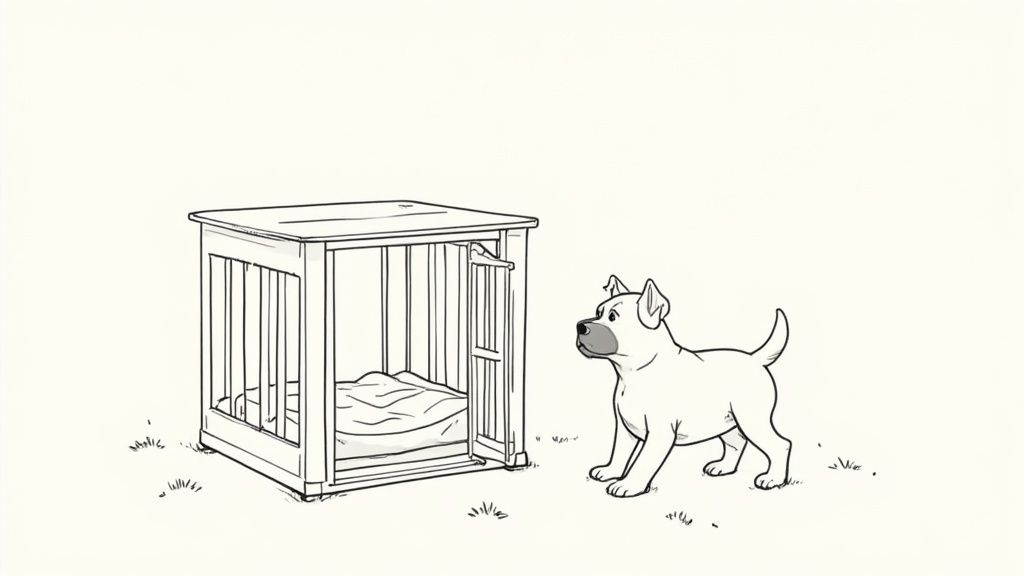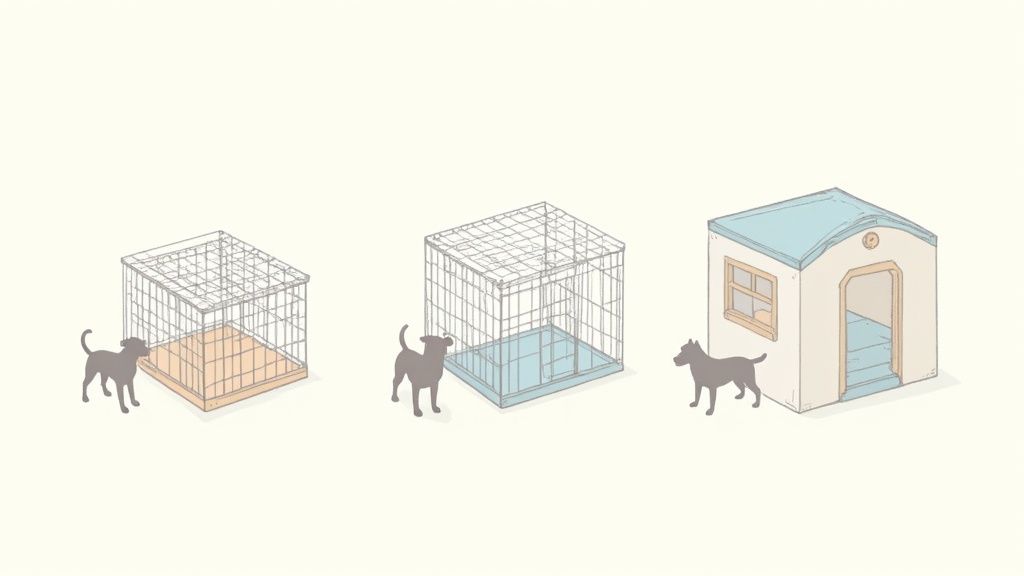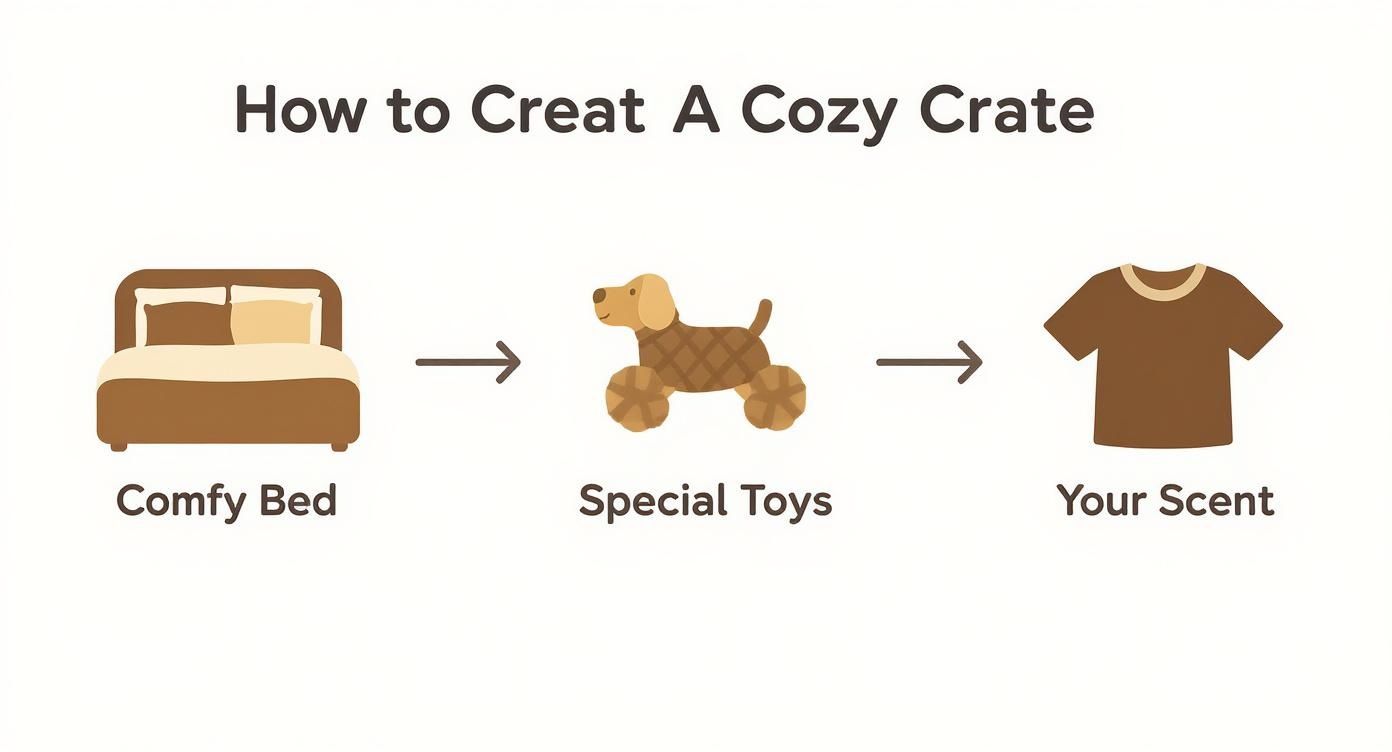Can You Crate Train an Older Dog? Gentle Steps from a Fellow Dog Lover
- ericavdippold
- Oct 22
- 11 min read
Here at my doggy daycare, I hear this question all the time: "I've got an older dog. Is it even possible to crate train them now?" Let me put that concern to rest right away. Yes, you can absolutely crate train an older dog! That old saying about not being able to teach an old dog new tricks? Total myth. And trust me, this is one "trick" that can genuinely make their life—and yours—so much better.
Why Bother Crate Training an Adult Dog?

Most folks think crates are just for puppies and potty training, but they offer so much more. For an adult or senior dog, a crate is something incredibly special: their very own personal den.
The whole goal is to change how you and your dog see the crate. It's not a cage or a time-out spot. It’s their private room, a safe space where they can go to escape the chaos of a busy house, noisy kids, or scary thunderstorms. This is a total game-changer for rescue dogs, who often crave a predictable, secure spot to decompress in a new, unfamiliar home.
A Safe Haven for Everyday Life
Think beyond just a comfy bed. A crate is one of the most practical tools you can have for your dog's safety and well-being. From my experience, it's a lifesaver in so many situations:
Safe Travels: A crate is the safest way for your dog to travel in a car, whether you're just heading to the vet or going on a big road trip.
Medical Recovery: If your dog ever needs surgery or is put on strict rest, a crate is essential for keeping them quiet and helping them heal properly.
Emergencies: During a fire, natural disaster, or any emergency where you need to leave quickly, having a crate-trained dog makes the process faster and far less stressful for everyone.
Vets will be the first to tell you how important this is. For senior dogs who might be losing their sight or hearing, the familiar comfort of their crate can make a scary vet visit or a chaotic day much more manageable. If you're looking for more reasons, many experts have shared insights on why crating is crucial for older dogs.
A properly introduced crate becomes a sanctuary. It’s a place where your dog knows they are safe, secure, and can completely relax.
To quickly sum it up, here’s why I’m such a big believer in introducing a crate to your older dog.
Why Crating an Adult Dog is a Great Idea
Benefit | How It Helps Your Older Dog |
|---|---|
Sense of Security | Provides a safe, predictable "den" where they can retreat when feeling stressed or anxious. |
Safety During Travel | Keeps them secure in the car, reducing the risk of injury during sudden stops or accidents. |
Aids in Recovery | Limits activity after surgery or injury, promoting faster and safer healing. |
Household Management | Offers a safe place to be when you have visitors, repair people, or can't supervise them. |
Emergency Preparedness | Makes evacuations or trips to the vet smoother and less traumatic for a nervous dog. |
In the end, it’s all about building a positive association. When your dog sees their crate as a wonderful place filled with their favorite toys and treats, you're not just teaching them a new behavior. You’re giving them a lifelong gift of security and peace of mind.
Choosing the Perfect Crate for Your Dog

Before you even think about tossing a treat inside, let's talk about the crate itself. I see all kinds of gear walk through my daycare doors, and I can tell you firsthand that the crate you choose can make or break your entire training effort. Think of it like buying your own bed—it needs to be comfortable, safe, and just the right size.
Getting this right is especially important for an older dog. You're trying to build a positive association from the ground up, and the crate needs to feel like a cozy retreat, not a cage. The wrong one can derail your progress before you even start.
Picking the Right Type
You'll generally find three main types of crates, and the best one really depends on your dog's personality. What works for a laid-back Lab might be a poor fit for an anxious Shepherd mix.
Let's look at the options:
Wire Crates: These are my usual go-to for home training. They have fantastic ventilation and let your dog see what's going on, which can help them feel less isolated. Most come with a divider panel, which is a game-changer for getting the size just right.
Plastic Crates: Often called "flight carriers," these offer a more enclosed, den-like vibe. For dogs that get a little overwhelmed by too much going on or just prefer a darker, cozier spot to nap, a plastic crate can be perfect.
Soft-Sided Crates: These are super lightweight and portable, making them great for travel or trips to a friend's house. I typically steer clear of these for initial training, though. If you have a dog that might scratch or chew to get out, they just won't hold up.
The Most Important Factor: Size
No matter which style you land on, getting the size right is non-negotiable. This is easily the most common mistake I see owners make, and it can create huge headaches down the road.
The rule of thumb is simple but critical.
Your dog should have just enough room to stand up without hunching, turn around comfortably, and lie down completely stretched out. Any larger, and you risk them designating one end as a potty spot and the other for sleeping.
Think of it as their personal bedroom, not a giant studio apartment. That snug, "just right" fit taps into their natural instinct to keep their sleeping area clean. When a dog feels secure in a properly-sized space, they are far more likely to embrace it as their own little sanctuary.
Turning the Crate Into Your Dog's Favorite Place
Alright, let's get to the fun part. Right now, your dog probably sees a plastic or metal box. Our mission is to transform that box into their own private, cozy den—a spot so great they choose to hang out there all on their own.
With an older dog, you’re often working against established habits or even bad past experiences. That's why we have to stack the deck in our favor by making the crate undeniably awesome from day one.
Make it the Coziest Spot in the House
First things first, no dog wants to nap on a hard plastic floor. Your goal is to make the crate so comfortable that it becomes the best snoozing spot in the house.
Add a Comfy Bed: A soft, properly-sized dog bed or a few plush blankets can make all the difference. You want it to be a place they can really snuggle into.
Leave Your Scent: Here's a pro tip that works wonders: toss in an old t-shirt you've worn but haven't washed. Your scent is a huge comfort to your dog, and having it in the crate makes this new space feel safe and familiar.
These small touches start building that positive connection we're after.
The only goal here is to create a powerful positive association. Every single thing that happens in or around that crate needs to be good.
Introduce High-Value, Crate-Only Goodies
To really seal the deal, we need to bring out the big guns: special treats and toys they can only have when they're in the crate. This creates a feeling of exclusivity and makes your dog actively want to go inside.
Think about what your dog goes absolutely bonkers for. A Kong stuffed with frozen peanut butter? A special long-lasting chew? Whatever it is, that's now the official "crate toy."
When you're ready, place this amazing item at the very back of the crate. Don't push them in; just leave the door wide open and let them discover it on their own. The idea is for them to walk in on their own terms to get their treasure.
Let them come and go as they please with the toy. This one step builds a fantastic foundation of "great things happen in here," which makes everything that comes next so much easier.
A Gentle Guide to Crate Introduction
This is where your patience really shines. We’re going to introduce the crate as a fantastic new game, not a scary cage. The secret here is to break it down into tiny, positive steps so your dog never feels overwhelmed or pressured.
It all starts by just rewarding your dog for being near the crate. Seriously, that's it. Forget about getting them inside for now. Toss a really good treat (think bits of chicken or cheese) near the crate, and when they wander over to check it out, give them lots of praise. We want their first thought to be, "Hey, good things happen around this new box!"
Building a Positive Vibe
Once your dog is totally cool with approaching the crate, we can up the ante just a bit. Start feeding their meals right inside the crate door, making sure to prop the door wide open so it can't accidentally swing shut. This creates a powerful connection in their mind: the crate is where delicious food magically appears.
Don't rush this stage. If your dog only sticks their head in to eat and keeps their back feet planted outside, that's a huge win! Let them build confidence at their own speed.
Here’s a look at how to make that crate an inviting space.

The infographic really nails the core components of a cozy den: comfy bedding, special toys they only get in the crate, and something that smells like you. When you layer these elements, you’re not just decorating a box; you’re creating a safe, multi-sensory retreat for your dog.
The First Time You Shut the Door
After a few days of this positive association work—and only when your dog is calmly walking into the crate on their own—you can try closing the door. And when I say "try," I mean for just one second. Close it, immediately open it, and give them a treat. The goal is to show them that a closed door is no big deal because it always opens right back up.
From here, it's all about small, gradual increases. We’re talking tiny increments of time, always ending on a positive note before they get anxious. Consistency and patience are everything. Respecting your dog’s pace is what makes this a stress-free lesson instead of a battle.
Throughout this entire process, you need to become an expert at reading your dog's signals.
Pay close attention to their body language. A relaxed posture, soft eyes, and a loose, waggy tail mean you're on the right track. If you see signs of stress—like lip licking, excessive yawning, or a tense body—you've moved too fast.
If that happens, don't sweat it. Just take a step back to whatever you were doing last that they were comfortable with. This isn't a race; it's an exercise in building trust. To get more fluent in what your dog is trying to tell you, check out our guide to understanding dog body language. Honestly, it's one of the most valuable skills you can have as a dog owner.
Navigating Common Crate Training Challenges
Let’s be honest, training an older dog, especially a rescue, isn't always a walk in the park. I've seen it all at my daycare—dogs who take to their crate immediately and others who treat it like a medieval torture device. If you hit a bump in the road, please don't get discouraged! This is completely normal.
Whining and barking are probably the most common hurdles you'll face. My first rule is simple: make absolutely sure all their needs are met. Did they just have a potty break? Are they thirsty? Once you’ve checked all the boxes and you know they're comfortable, the best strategy is often the hardest one: ignore the attention-seeking noise.
It feels wrong, I know, but if you run to them every time they whine, you're just teaching them that making noise gets them what they want. It becomes a game. Instead, you have to wait for a quiet moment—even if it's just a few seconds of silence—and then reward that quiet with praise or by opening the door.
Addressing Deeper Fear and Anxiety
Some dogs, particularly those with a tough past, aren't just being difficult; they're showing genuine fear or separation anxiety. This is different from simple whining. You'll know it when you see it—it's true distress.
For these pups, you have to be extra gentle. Never, ever force them into the crate. That will only make things a hundred times worse by confirming their fears.
Take a big step back. Sometimes that means going all the way back to square one, just rewarding them for looking at the crate from across the room. We had a rescue beagle at the daycare who was terrified of enclosed spaces. We took the door completely off his crate for a full month and just tossed his favorite treats in there until he started napping inside on his own. You can find more strategies for this in our guide on how to reduce dog separation anxiety.
The key is to rebuild trust. Your dog needs to understand, through your patient actions, that the crate is a safe place and that you will always come back for them.
Rescue organizations have seen this process transform a dog’s life. When you approach it with compassion, crate training gives these dogs a secure den that helps them feel safe and less stressed. In fact, crate-trained rescues often have fewer accidents and show reduced anxiety levels overall. You can discover more insights about crate training rescue dogs on offleashgeorgia.com. Your patience here will pay off, I promise.
Your Crate Training Questions Answered
Over the years at my daycare, I've answered hundreds of questions about whether you can crate train an older dog. It’s a topic that comes with a lot of uncertainty, so I wanted to tackle some of the most common ones I hear. My goal is to give you clear, straightforward answers from someone who sees these scenarios play out every single day.
Think of this as a quick chat over the fence, just clearing up those last few nagging doubts.
How Long Can I Leave My Older Dog in a Crate?
This is a big one, and it’s so important to get right. For a fully trained adult dog, a good maximum during the day is around four to six hours. Any longer than that is really pushing it, in my opinion.
But remember, senior dogs often need more frequent potty breaks, so you have to adjust for your specific dog. I never recommend crating a dog for a full eight-hour workday without having someone—a friend, a walker, or a neighbor—stop by for a break.
The crate must always remain a positive, safe space. Using it for long-term confinement can quickly undo all of your hard work and create anxiety.
What if My Rescue Dog Is Terrified of the Crate?
This breaks my heart, but it's incredibly common. A previous negative experience can make a crate seem like the scariest thing in the world. The absolute key here is to move at a snail's pace and never, ever force them inside.
Your patience is your best tool. I always suggest starting by simply placing the crate in the room and taking the door completely off for the first week or two. Drop high-value treats near it, then just inside the entrance, rewarding your dog for just looking at it or sniffing it.
This process is all about rebuilding trust and showing them they are in control. It may take weeks, or even months, but your patience will be rewarded with a dog who feels genuinely safe.
My Dog Was Crate Trained but Now Hates It. What Happened?
It’s surprisingly common for a dog to suddenly decide they hate the crate. This can be triggered by something as simple as a loud clap of thunder while they were inside or just from being out of practice. Often, a sudden change in behavior can signal something deeper is going on. For more insights, you might find it helpful to learn more about understanding dog behavior change causes and solutions in another one of our articles.
The best approach is to treat it like you're starting over from the very beginning. Re-introduce the crate as if it's brand new. Make it super comfy again, feed their favorite meals inside with the door open, and use lots of praise. You’re not truly starting from scratch; you're just methodically rebuilding that positive association.
At Pawcation, we know every dog is unique. If you're near King of Prussia, PA, and need a loving place for your dog to stay, we'd be honored to welcome them. Check us out at https://pawcation.co.
Comments